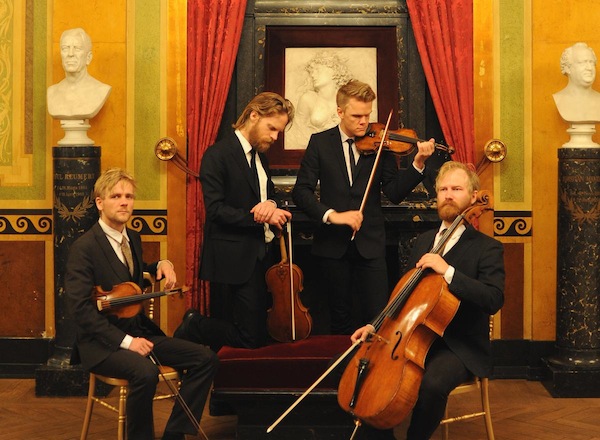Danish Quartet illuminates Beethoven’s music across three eras

The Danish String Quartet played at the Broward Center’s Amaturo Theatre Saturday night. Photo: Caroline Bittencourt
Many of the world’s greatest string quartets touch down in South Florida, thanks to the region’s several excellent concert series. But even in today’s golden age of chamber ensembles, few will match the tonal luster, ensemble precision and interpretive brio of the Danish String Quartet.
This ensemble, which today consists of three Danes and a Norwegian, played an all-Beethoven concert Saturday at the Broward Center in Fort Lauderdale, in a performance intended to span the breadth of the composer’s career.
They played a quartet from Beethoven’s Opus 18, where the young composer displayed mastery of the form inherited from Haydn and Mozart. Then came a work from the Opus 59 set, classic, middle-period works published around the time of the Violin Concerto and Fifth Symphony. Finally they finished with the Quartet No. 14, Opus 131, a searing, challenging, deadly serious work completed the year before his death.
The Danish Quartet opened with Beethoven’s String Quartet No. 3 in D major, a gracious, Classical-style work. From the first notes, the quartet’s ensemble tone was striking–well balanced and transparent, light but richly resonant.
They brought an airy buoyancy to the opening Allegro, beginning unusually quietly and then building to passages of exultant joy. Their compact tone, topped by the graceful playing of first violinist Rune Tonsgaard Sørensen, gave a polished account of the Andante. The concluding movements were full of Haydnesque humor, right down to the witty, quiet ending, yet still played with a richness and grandeur that expressed the young composer’s emerging ambitions.
Beethoven’s String Quartet No. 7 in F major, Op. 59, no.1 opened in a subdued manner, with cellist Fredrik Schøyen Sjölin playing the first theme in a way that communicated quiet assurance rather than the heroic extroversion favored by other players. But the movement soon acquired all the muscle it needed with their rugged but virtually unblemished playing.
In the Allegretto, the music and the quartet’s style evoked the Beethoven of the Fifth and Third symphonies. There were terse motifs delivered in a crisp, clipped manner. The intense outbursts were nearly orchestral in sonority–yet always crystal-clear–in climactic passages of dense, dramatic chords. Pensive running passages has a quiet yet ominous power.
The Adagio unfolded in an unhurried manner, with effective restraint for one of those noble Beethoven slow movements in which the emotional power builds slowly but forcefully. Violinist Sørensen brought quiet eloquence to the poignant opening melody. Cellist Sjölin brought a mellow humanity to it when it came his way. As the theme moved from instrument to instrument, accompanied by running figures in the ensemble, they made the music swell and subside with extraordinarily tight interpretive precision. Toward the end, when Sørensen and second violinist Frederik Øland played the theme together, it arrived with piercing intensity. The concluding Allegro was big, rumbling and symphonic.
The second half of the concert was devoted to Beethoven’s Quartet No. 14 in C-sharp Minor, Op. 131.
Although this quartet is unlikely to approach the popularity of the composer’s best-known symphonies, concertos or piano sonatas, it’s widely considered one of his masterpieces. The Danish ensemble gave a performance of taut concentration that spanned the quartet’s landscape of inward contemplation, rollicking energy and raw-edged emotion.
The musicians opened softly, allowing the Adagio’s counterpoint to build in impact, playing the bleak passages for two violins or viola and cello with immense focus. Their ability to play pianissimo passages with clear, hall-filling resonance achieved an unusually wide dynamic range that allowed for greater expressivity.
Playing in a staccato manner, with sudden stops and decelerations, they played the Presto as a mirthless burst of manic energy. Particularly effective was a passage toward the end, where they bowed in a manner that produced eerie, woody sounds, a ghostly echo of the opening high spirits.
The concluding Allegro unfolded with a grim drive that kept up to the end. The strongly marked rhythm that shapes the movement was attacked with blistering force. The ensemble’s way with pianissimos paid off here, with sinewy, soft passages full of ominous energy, as the undergirding rhythm powered forward. The high passage in violins with which the movement climaxes was just the searing, emotional high point it should have been. This was a great performance of one of Beethoven’s last musical statements.
Posted in Performances
Leave a Comment
Sun Apr 15, 2018
at 1:04 pm
No Comments
